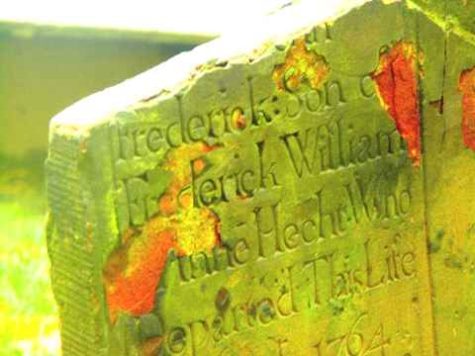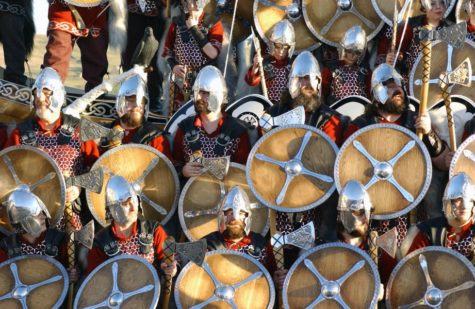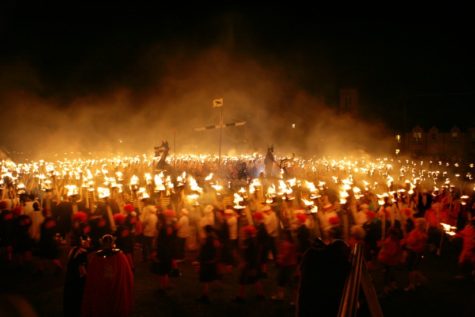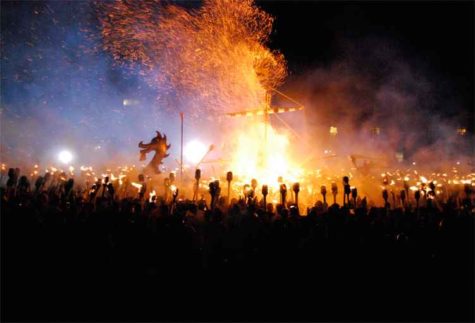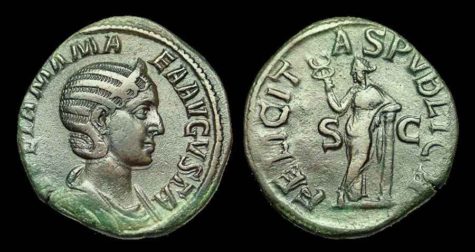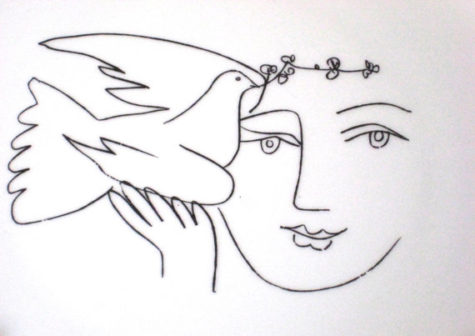Monthly Archives: January 2017
Baking is appropriate for celebrating Imbolc, and we often make Crescent cakes for the end of our Imbolc ritual. Here is our circle’s favorite recipe:
- 1 1/4 cups Flour
- 3/4 cup Sugar
- 1 cup Finely Ground Almonds
- 3 drops Almond Extract
- 1/2 cup Butter or Margarine, softened
- 1 tablespoon Honey
- 1 Egg Yolk
In a large mixing bowl, combine the first four ingredients. Add the butter, honey and egg yolk and mix together well. Cover with aluminum foil or plastic wrap, and then chill for 1 1/2 to 2 hours in the refrigerator.
When ready, pinch off pieces of the dough (about the size of plums) and shape them into crescents. Place the crescents on a well-greased cookie sheet and bake in a 325-degree preheated oven for approximately 20 minutes. This recipe yields 20 to 25 crescents.
From Rose Ariadne
The last day of each of the lunar months is the sacred day of the triple goddess of crossroads and the patroness of Witches, Hekate.
Hekate had many names and titles: Hecate Trevia, “of the three ways”; Hecate Phosphoros, “the light bringer”; Hecate Nykterian “of the night”; and Hecate Basileia, “Hecate Queen.” On this night of the waning Moon we have a perfect opportunity to work with this goddess and ask for her blessing to illuminate our darkest times, and grant us her protection.
Hecate, goddess of the crossroads, hear my cry,
Protect and guard me under your midnight sky.
Hecate Phosphoros “she who brings the light,”
Hecate Trevia bless me with your wisdom tonight.
Hekate’s ancient devotees held dinners in her honor, known as Hekate Suppers. Once upon a time, these dinners were consumed outside under the dark moon, ideally at a crossroads. One plate was reserved for Hekate; after her devotees dined, just before they departed, Hekate’s plate was laid down at the crossroads.
Foods associated with her were prepared. The entree was usually fish, especially red mullet. Devotees feasted and celebrated. Offerings and leftovers were placed outside the door or at a crossroads for Hekate and her hounds.
Even way back when, cynics scoffed that food placed outside was actually consumed by feral dogs and homeless people without realizing that this is Hekate’s intent: this is one way she accepts offerings. (The Church was still trying to eradicate this ritual as late as the eleventh century.)
A typical Hekate Supper menu includes eggs, fish roe, goat and sheep cheese, sprats, red mullet – a scavenger fish that was the subject of many taboos – garlic, mushrooms, and honey cake surrounded by blazing torches or cakes decorated with miniature imitation torches (candles). Other ideas include garlic, salmon, honey, and edible flowers.
Traditionally whatever is given to Hekate cannot be reclaimed. Thus, do not break out your priceless set of china; lay the meal on the ground or use a serving dish that will be incorporated into the offering. Once the offering is laid down, depart without looking back. Hekate determines who picks up the offering.
Smaller, private offerings may be left at a crossroads, too:
- Place offerings on a plate or flat stone and leave them at a crossroads after dark.
- Make your invocation and then walk away without looking back.
- Do not return for the plate, or any part of the offering, but consider it part of your gift.
Offerings can include the following:
- Eggs
- Garlic and honey (especially lavender honey)
- Croissants and crescent shaped breads and pastries
- Candles
- Incense
- Images of dogs, especially black dogs
- Actions on behalf of dogs
Encountering or hearing a dog is an indication that your petition has been heard.
Other nights sacred to Hekate:
- Friday the 13th – particularly if it falls in the month of August.
- November 16th is Hekate Night
- August 13th, in Italy, a festival is shared between Diana and Hekate
Sources:
- Invocation by Ellen Dugan
- The Powers That Be
January 31 is Disfest or Disablot which is a day of sacrifice honoring the Disir. The Disir are all the female relatives from the eons of time that have passed over and over see as well as protect their living family members.
In some homes every candle and light is lit in the house to honor them. A sacrifice of the very best food and drink in the house is given to the Land Wights as well. It is a day of remembrance and honoring the females that passed over and to thank them for their loving protection.
Source: Pagan Calendar
Up Helly Aa refers to any of a variety of fire festivals held in Shetland, in Scotland, annually in the middle of winter to mark the end of the yule season and celebrate the arrival of the Vikings. Traditionally held on the last Tuesday in January, the festival involves a procession of up to a thousand guizers in Lerwick and considerably lower numbers in the more rural festivals, formed into squads who march through the town or village in a variety of themed costumes.
The current Lerwick celebration grew out of the older yule tradition of tar barreling which took place at Christmas and New Year as well as Up Helly-Aa. After the abolition of tar barreling, permission was eventually obtained for torch processions. The first yule torch procession took place in 1876. The first torch celebration on Up Helly-Aa day took place in 1881. The following year the torch lit procession was significantly enhanced and institutionalized through a request by a Lerwick civic body to hold another Up Helly-Aa torch procession for the visit of the Duke of Edinburgh. The first galley was burned in 1889.
There is a main guizer who is dubbed the “Jarl”. There is a committee which you must be part of for fifteen years before you can be a jarl, and only one person is elected to this committee each year.
The procession culminates in the torches being thrown into a replica Viking longship or galley. The event happens all over Shetland, but it is only the Lerwick galley which is not sent seaward. Everywhere else, the galley is sent seabound, in an echo of legendary Viking sea burials.
After the procession, the squads visit local halls (including schools, sports facilities and hotels), where private parties are held. At each hall, each squad performs its act, which may be a send-up of a popular TV show or film, a skit on local events, or singing or dancing, usually in flamboyant costume.
Due to the often-flamboyant costumes and the large quantity of males dressing up as females (Traditionally, the Capital festival does not permit women to partake in the squads) in the Lerwick festival, it has earned the joke name ‘Transvestite Tuesday’. The photos below show a few examples of the festival’s highlights.
Source: Wikipedia
Official Website: Up Helly Aa
Called Feriae Sementivae, this one or two day Roman festival was moveable, but generally began between January 24 and January 26. Sacred to Tellus, and Ceres, this festival was for the protection of seeds, either those sown the previous fall, or those to be sown in the spring. During Sementivae plowing oxen were decorated with garlands, and puppets or masks were hung from tree branches.
This is an excellent time to begin to think about planting a “Witch’s Garden” and to do spellwork involving seeds. Spiritually and metaphysically, this is an optimum time to sow the internal seeds of what we hope to bring forth as the year unfolds.
- Presiding Goddess: Nokomis
- Themes: Prosperity, Luck, Providence
- Symbols: Gold, Golden items, Corn
About Nokomis: In Algonquin tradition, Nokomis is the “grandmother” who supplies us with the earth’s riches and gives nourishment to humankind in times of need. When people are hungry, Nokomis provides food. When there is no food to be found, she offers to let us consume her spirit, thereby continuing the cycle of life.
To do Today: Today marks the anniversary of the discovery of gold in California and the resulting expansion westward in the United States. In keeping with this prosperous, fortunate theme, wear or carry something gold today to bring a little more of Nokomis’s abundance your way.
For financial improvements, especially if you have any pressing bills, eat corn (any type) today. Before consuming it pray to Nokomis, saying:
“Grandmother, see the sincerity of my need.
Go to your storehouse and dispense _____
(fill in the minimum amount you need to get by)
so that I might meet my obligations.”
Eating the corn internalizes the energy of the prayer so opportunities to make money start manifesting.
If you’re pressed for time, grab a kernel of unpopped popcorn and put it in your wallet or purse to keep Nokomis’s prosperity (and your cash) where it’s needed most.
The History:
In January of 1848, James Marshall had a work crew camped on the American River at Coloma near Sacramento. The crew was building a saw mill for John Sutter. On the cold, clear morning of January 24, Marshall found a few tiny gold nuggets. Thus began one of the largest human migrations in history as a half-million people from around the world descended upon California in search of instant wealth.
From: 365 Goddess and other sources
January 17 is an excellent day for all magickal workings having to do with luck, success, and money.
It is the feast day of Fausta Felicitas, an ancient Roman Goddess of Good Fortune and Lucky Happenstance. Her name is essentially two words of the same meaning, likely doubled up for emphasis, for fausta in the Latin is the adjective “favorable” or “auspicious”, while felicitas is the noun meaning “luck”, “good fortune” or “happiness”; Her name can be translated as the nicely redundant “Lucky Luck”, though “She of Auspicious Good Fortune” probably sounds better.
By the way, the Latin felix, “happy”, and felis “cat” are related, through the theme of “fruitfulness”, as cats have many young; I’m tempted, however, to interpret the connection as referring to purring, an obvious and defining feature of happy cats.
Her name evokes the Latin saying “Quod bonum faustum felix fortunatumque sit!”, which translates as “May it be good, lucky, happy, and blessed!” According to Cicero (who lived 106-43 BCE), this phrase had been used since ancient times as the proper ritual formula said at the beginning of all kinds of projects or events to assure an auspicious outcome — for example, when cities or colonies were founded, at public rites, at the opening of festivals, or at sacrifices.
Images of this Goddess are found most often on Roman coins.
When casting the spells, the addition of the Latin saying “Quod bonum faustum felix fortunatumque sit!” as well as invoking the power of the Goddess herself would seem to ensure an even more successful outcome.
Found at The Obscure Goddess Online Directory
In ancient Greece, on the 16th and 17th of January, there was held a festival in which offerings were made to the Wind Gods of the eight directions.
Black lambs were offered as sacrifices to the destructive winds, and white ones to favourable or good winds. Boreas (North Wind) had a temple on the river Ilissus in Attica, and between Titane and Sicyon there was an altar of the winds, upon which a priest offered a sacrifice to the winds once in every year. Zephyrus (West Wind) had an altar on the sacred road to Eleusis.
If you are not big on animal sacrifices, you might consider the following:
- Singing or playing The Winds Four Quarters
- Doing a Ritual to the North Wind (since it is January)
- Learn how to use the four winds in magick.
- Practice some windy magick
Alternatively, you might go outside and stand in a high place and offer a pinch of herbs or spice to each of the four winds. Something sweet to sweeten whatever might come your way, might be appropriate.
More about these Windy Gods can be found at The Powers That Be
The Roman Goddess Concordia is honored and feasted on many different days throughout the year. She is the Goddess of Harmony and Good Relations, and her presence at any grand festival was likely required.
According to some calendars, January 16 is listed as the Festival of Concordia. I could not find much more about this particular day. I would assume that any festival involving this Goddess would or could include the following:
- Forgiveness
- Olive branches
- Coming together to work out differences
- Harmony – maybe even singing in harmony
- Sufi dances of Universal Peace might also be appropriate
- Ruler: Freya, Venus
- Colors: Emerald green or pink
- Power Hours: Sunrise and the 8th, 16th, and 24th hours following.
- Key Words: Love, money, health
 It is easy to spot the ruler of this day by its name. In the word Friday, we see the roots of the name of the Norse goddess Freya, a goddess of love and fertility, and the most beautiful and propitious of the goddesses thus the verse “Friday’s child is loving and giving.”
It is easy to spot the ruler of this day by its name. In the word Friday, we see the roots of the name of the Norse goddess Freya, a goddess of love and fertility, and the most beautiful and propitious of the goddesses thus the verse “Friday’s child is loving and giving.”
In Spanish this day of the week is called Viernes and is derived from the goddess Venus. Matters of love, human interaction, the fluidity of communication, sewing and the creation of artistic garments, household improement, shopping, and party planning all fall under the aspects of Friday and its ruling planet, Venus.
Friday’s angels are Ariel/Uriel, Rachiel, and Sachiel. Rachiel also concerns himself with human sexuality and is a presiding spirit of the planet Venus.
On Fridays, the hour of sunrise and every eight hours after that are also ruled by Venus, and that makes these times of the day doubly blessed. These four hours are the strongest four hours for conducting ritual. Check the local newspaper, astrological calendar, or almanac to determine your local sunrise.
From:


